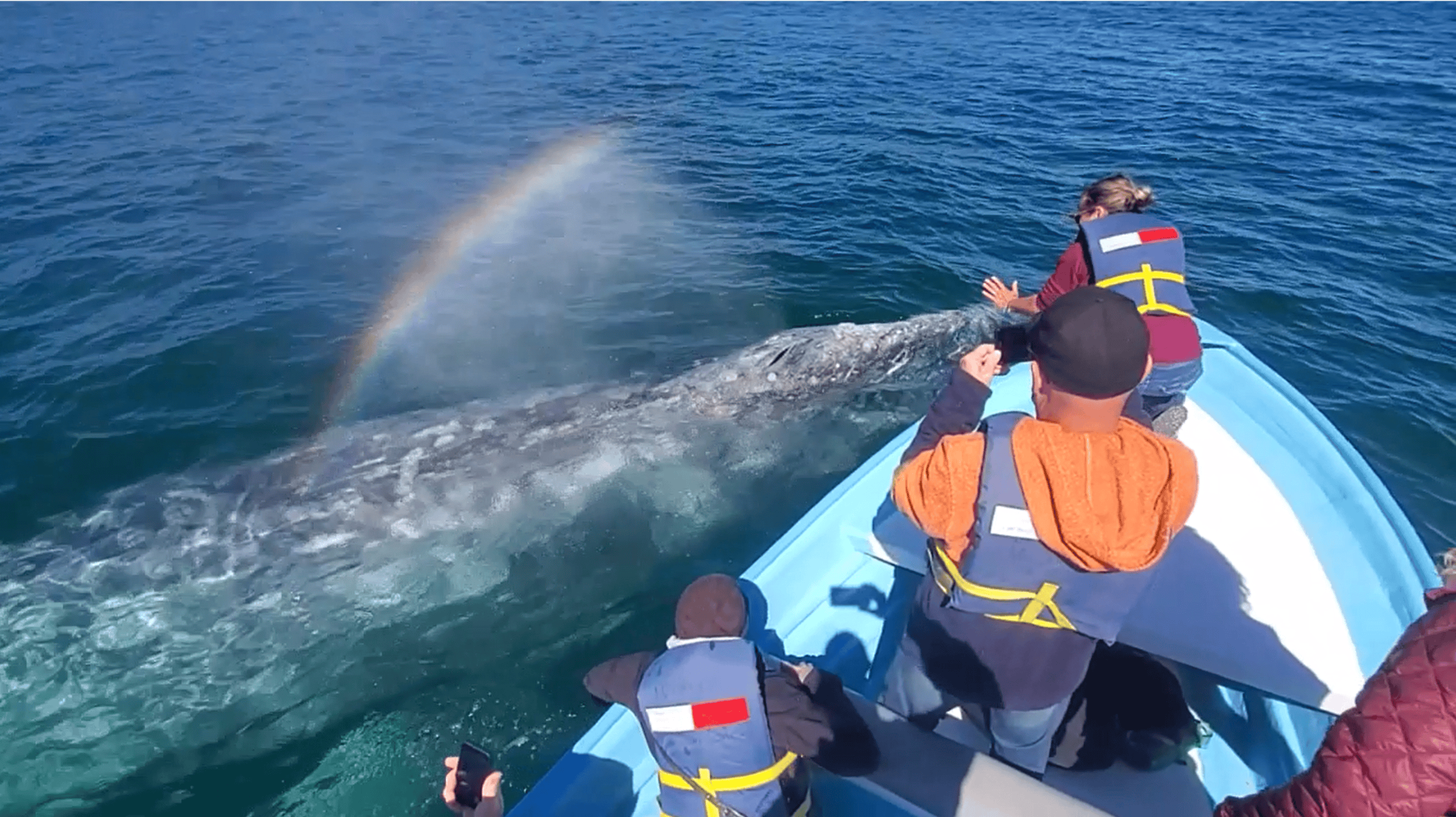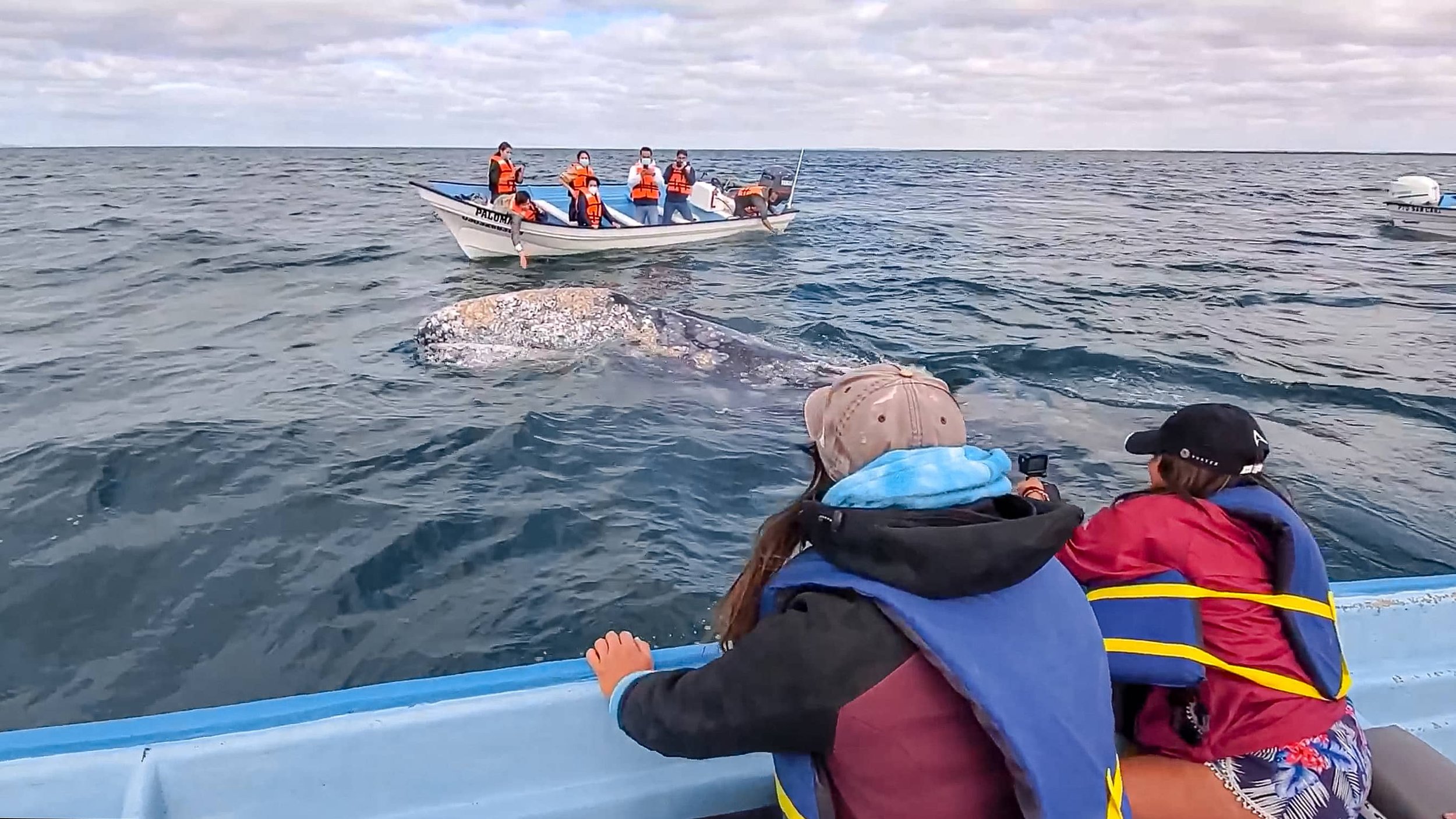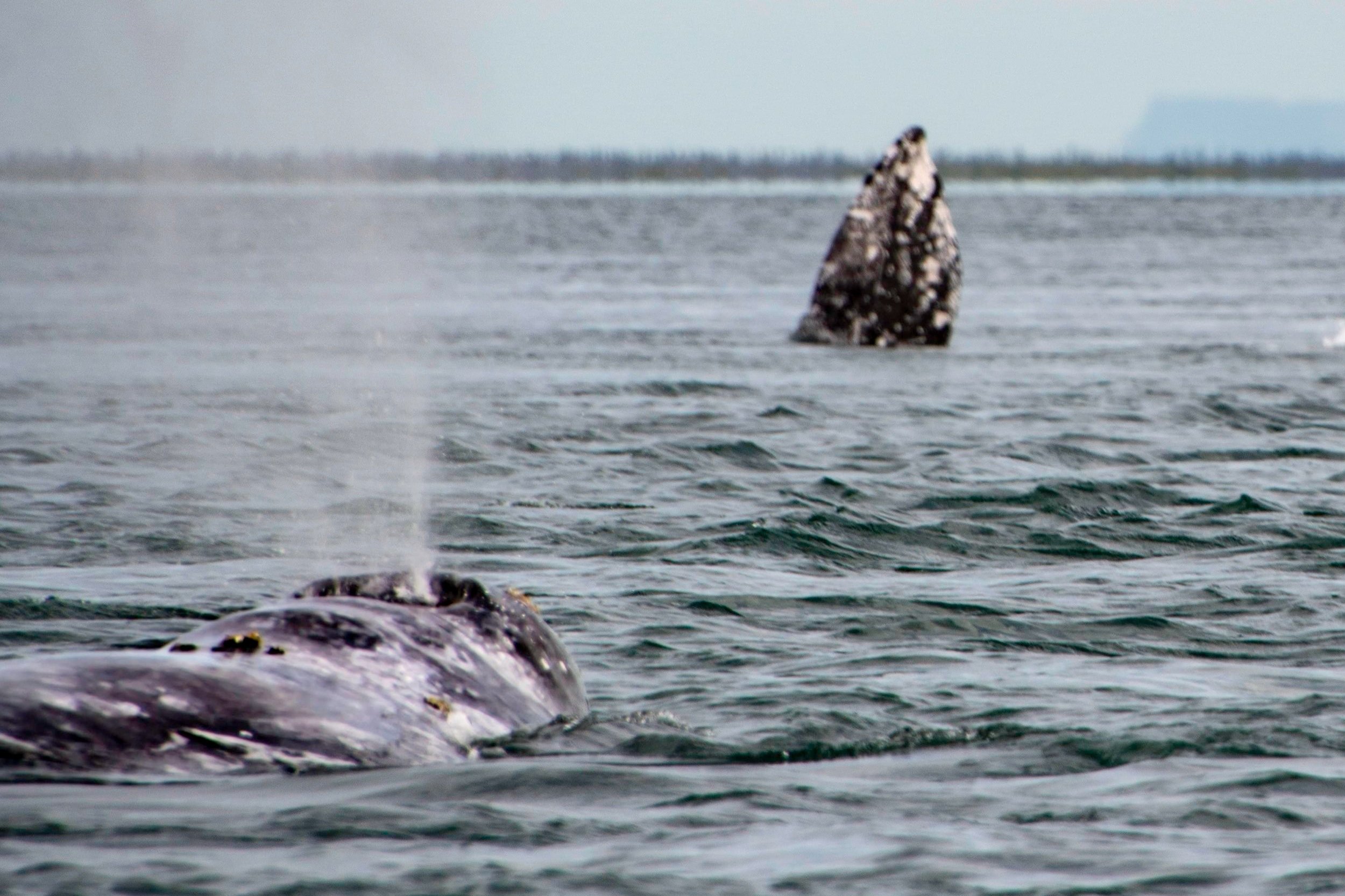Touching Gray Whales in Baja California: A Complete Guide to an Unforgettable Experience
Normally we do not condone the touching of animals, and we believe that animals should be left to their own will… but the gray whales of Baja Mexico seem to have their own plans, and ask “What’s all this no touching nonsense?? Come here human and rub my face!!” Which brings us to the purpose of this article - to highlight the importance of gray whales in Baja California / Sur and to provide an overview of their migration patterns, behaviors, conservation efforts, and the ethical guidelines for interacting with them. Through this article, we hope to increase awareness and appreciation for these incredible animals and the role they play in the ecosystem of Baja California / Sur.
General information about gray whales
Gray whales, also known as Eschrichtius robustus, are a species of baleen whale that can be found in the northeastern Pacific Ocean. These magnificent creatures can grow up to 50 feet in length and weigh up to 40 tons. They are known for their distinctive gray color, as well as their friendly and curious nature.
Importance of gray whales in Baja California / Sur
Gray whales hold a special place in the hearts of many people, particularly in Baja California / Sur. Every year, thousands of gray whales make the journey from the cold waters of the Arctic to the warm lagoons of Baja California / Sur to mate and give birth. This annual migration is a spectacular natural phenomenon that attracts visitors from all over the world.
Gray Whale Migration
Overview of gray whale migration patterns
Gray whales are known for their long-distance migrations, which can cover a distance of up to 14,000 miles round-trip. Every year, gray whales leave the Arctic waters where they feed during the summer and head to the warmer waters of Baja California / Sur, Mexico to mate and give birth. The migration typically takes place between December and April, with the majority of gray whales arriving in Baja California / Sur between January and March.
Specifics of the gray whale migration to Baja California / Sur
The gray whale migration to Baja California / Sur is one of the longest mammal migrations on earth, and it's truly a remarkable sight. The gray whales make their way down the west coast of North America, passing through the Gulf of Alaska, British Columbia, and Washington, before reaching the waters of Baja California / Sur. Along the way, they stop to rest and feed, and can sometimes be seen from shore.
Reasons for the migration
The gray whale migration is driven by a number of factors, including the need to mate and give birth in warmer waters, as well as the availability of food. The Arctic waters where gray whales feed during the summer months are rich in plankton, krill, and small fish, but as the water cools and the food supply decreases, the whales must migrate to warmer waters where they can find food and give birth.
Best time to witness gray whale migration in Baja California / Sur
The best time to witness the gray whale migration in Baja California / sur is between January and March. During this time, the majority of gray whales have arrived in the area, and they can be seen close to shore as they mate and give birth. It's important to note that the best time to see the whales can vary from year to year depending on factors such as ocean currents and weather conditions.
Best Place to see gray whales in Baja California / Sur
The best places to experience gray whale touching in Baja California / Sur are at Magdalena Bay, Ojo de Liebre Lagoon, and San ignacio Lagoon. When planning to witness the incredible gray whale migration in Baja California, it is important to choose an eco-friendly tour operator. These operators prioritize the well-being of the whales and the environment, and have guidelines in place to ensure that your tour does not disturb the whales or damage their habitat. They are also committed to educating visitors about the importance of conservation and the ethics of interacting with these magnificent animals. By choosing an eco-friendly tour operator, you can be sure that you are not only having a memorable experience but also contributing to the preservation of gray whales for future generations. Here at Baja Wild Encounters we prioritize the well-being of all of the animals and their habitat, by only working with locals who have a deep understanding and respect for these magnificent creatures"
Gray Whale Behavior in Baja California / Sur
Feeding habits
Gray whales are known to be opportunistic feeders, which means they will eat a variety of different prey depending on what is available. In the Arctic waters where they feed during the summer, gray whales consume large amounts of plankton, krill, and small fish. However, when they reach Baja California / Sur, their diet shifts to include bottom-dwelling organisms such as amphipods and other crustaceans.
Breaching and other behaviors
Gray whales are known for their acrobatic displays, particularly breaching, which is when they launch themselves out of the water and fall back with a huge splash. Breaching is thought to be a form of communication, as well as an opportunity for the whale to get a better look at its surroundings. Gray whales in Baja California / Sur also frequently engage in other behaviors such as spyhopping, which is when they raise their head out of the water to look around, and tail slapping, which is when they slap their tail flukes on the surface of the water.
Interactions with humans - is it right to touch gray whales?
Gray whales in Baja California/Sur have a unique behavior of approaching boats, even allowing people to touch them. These whales associate boats as non-threatening as whaling in the Mexican lagoons was banned in 1870s. Most gray whales seen in this area range between 26-47 years old, with the oldest recorded at 76 years old, therefore, these gray whales have not experienced any slaughtering. Over the years, the local fishermen have grown a huge respect for the gray whales, and the whales have found peace in them. The reason for the whales approaching boats is not known, mainly because we are not whales, but curiosity seems to be the most common answer. Touching the gray whales is allowed if they initiate contact first. It is important to respect guidelines and regulations for interacting with gray whales for safety of both humans and whales.
Gray whale's unique characteristics that make them special
Gray whales have a number of unique characteristics that make them special, including their long-distance migration, their acrobatic displays, and their interactions with humans. But what truly sets gray whales apart is their intelligence and adaptability. Gray whales have been observed using tools, such as using their tail to stir up the sediment on the ocean floor to uncover prey, and have been known to form strong social bonds with other whales.
Gray Whale Conservation in Baja California / Sur
Overview of the current population
Gray whale populations in Baja California / Sur have been on the rise in recent years, thanks to conservation efforts. The Eastern Pacific gray whale population, which migrates to Baja California / Sur, has increased from an estimated low of 2,000 in the 1940s to around 27,000 today. This is a testament to the effectiveness of conservation efforts in protecting these magnificent creatures.
Threats to gray whales in Baja California / Sur
Despite the positive trend in gray whale populations, there are still threats that put them at risk. These include commercial hunting, entanglement in fishing gear, and ship strikes. Climate change and ocean pollution also pose a threat to their food sources and habitat.
Efforts to protect and conserve gray whale populations
To protect gray whale populations, a number of conservation efforts have been put in place. These include the creation of marine protected areas, regulations on hunting and fishing, and research programs to better understand the animals and their habitat. Additionally, ecotourism provides an alternative source of income to local communities and helps to raise awareness about conservation efforts.
Role of ecotourism in gray whale conservation
Ecotourism plays an important role in gray whale conservation in Baja California / Sur. Not only does it provide an alternative source of income to local communities, but it also raises awareness about conservation efforts and encourages people to take an active role in protecting these magnificent creatures. By observing gray whales in their natural habitat, tourists learn about the importance of conservation and the impact that human activities can have on gray whale populations.
Touching Gray Whales in Baja California / Sur
Regulations and guidelines for interacting with gray whales
Touching gray whales in Baja California / Sur is a once-in-a-lifetime experience, but it is also an important part of conservation efforts to protect these amazing animals. It is essential that we respect the guidelines and regulations set in place to ensure the safety and well-being of the gray whales. This includes keeping a safe distance and not approaching the whales too closely, as well as not separating mothers from their calves.
Ethical considerations
Interacting with gray whales in Baja California / Sur is a privilege, and it is important that we do so in an ethical and responsible manner. This includes not disturbing the whales' natural behavior, and not harassing or mistreating them in any way. By respecting the whales and their environment, we can ensure that the experience is a positive one for both the whales and the people involved.
Personal accounts of touching gray whales in Baja California / Sur
Many people who have had the opportunity to touch gray whales in Baja California / Sur describe it as an incredibly moving and humbling experience. The feeling of being in the presence of these magnificent creatures is something that will stay with them forever. It is an experience that is not to be missed and one that will leave a lasting impression.No matter how many videos you see, nothing compares to experiencing these gentle giants yourself, in person!
Tips for a safe and memorable gray whale touching experience
To have the best experience possible when touching gray whales in Baja California / Sur, it is important to be prepared. This includes researching the tour operators, choosing a reputable and ethical operator, and being aware of the regulations and guidelines for interacting with the whales. It is also important to be mindful of the whales' well-being and to respect their natural behavior.
Conclusion
Call to action for conservation efforts
It is essential that we continue to work towards protecting and conserving gray whale populations in Baja California / Sur. This can be done by supporting conservation organizations, volunteering, and advocating for responsible ecotourism. By doing our part, we can ensure that future generations will have the opportunity to experience the wonder of these gentle giants.
Additional resources for learning more about gray whales in Baja California / Sur
There are many resources available for learning more about gray whales in Baja California / Sur. This includes books, documentaries, and online resources. Researching and educating oneself about these amazing animals is a great way to deepen the experience when visiting Baja California / Sur. You can also join one of our educational tours to find out more for yourself.
Encouragement to visit Baja California / Sur
Baja California / Sur is a unique and beautiful destination that offers many opportunities to experience the natural wonders of the world. The gray whale migration is just one of the many reasons to visit this incredible place. We highly encourage you to plan a trip to Baja California / Sur and witness this amazing phenomenon for yourself. Not only are the gray whales a huge highlight, but you can also see The Biggest Ray Migration in the World, The Mexican Sardine Run, 8 of the 10 Biggest Whales in the World, and so much more! Every month has something spectacular in Baja Mexico!
In conclusion, visiting the gray whales in Baja California / Sur is an unforgettable experience, but it is also an important part of conservation efforts to protect these amazing animals. By respecting the guidelines and regulations set in place, and by being mindful of the whales' well-being, we can ensure that the experience is a positive one for both the whales and the people involved.
If you’d like to experience this bucket list encounter for yourself, we have both day trips and multiday trips to see the gray whales and more!






